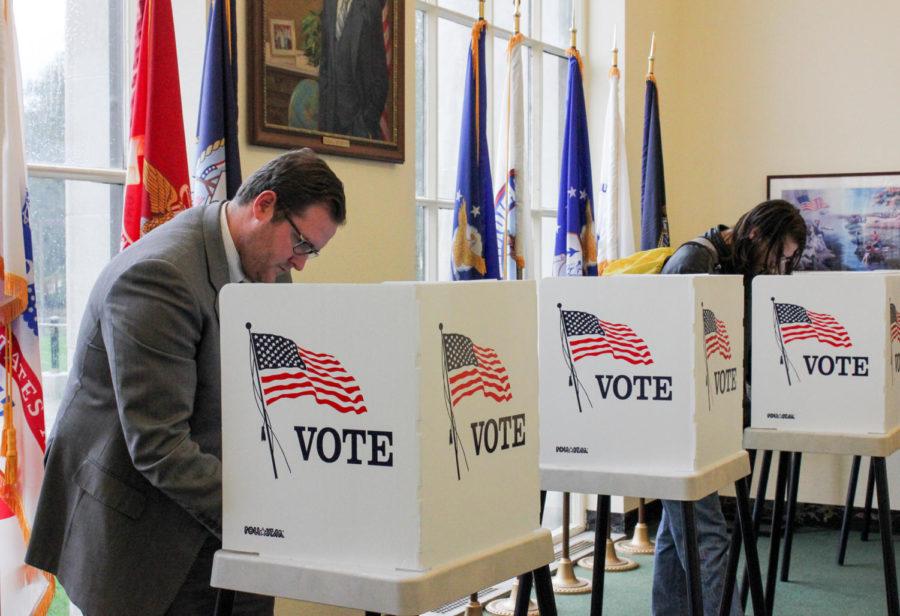Students encouraged to vote now more than ever in 2014 midterm elections
Jay Halbur, left, and Stephen Jensen vote in the Col. Pride Veterans’ Lounge in the Memorial Union on Oct. 13. Early voting takes place in the Memorial Union from 9 a.m. to 4 p.m. Oct. 13 through 17.
November 4, 2014
During the last midterm election in 2010, only 28.8 percent of eligible 18-29 year old voters in Iowa cast a ballot.
This year, Story County officials have been trying to educate students about the voting process and its rules in order to increase turnout.
“We were at the Memorial Union for an entire week this year like we were in 2012,” said Lucy Martin, Story County auditor. “We are trying to get a lot of questions answered before Election Day.”
Martin said students have the choice to vote in their hometowns or here in Ames. In order to vote in Ames, students must register with proof of residence and identification, such as a driver’s license, passport or military ID.
Student organizations on campus such as ISU Democrats and ISU Republicans have also been reaching out to students.
“We’ve been chalking, tabling, calling, texting, knocking on doors and using social media,” said Zoe Kustritz, ISU Democrats president.
Kustritz said it is very important for students to vote because the United States, as a democracy, cannot function and improve without an educated and engaged population.
“Students can print out their directory information and bring their ID with an expiration date on it if they did not already register to vote before Election Day,” Kustritz said.
Kustritz said there is a lot of power in a single vote, especially in Iowa. This is a battleground state; every vote is worth a lot, she said.
“We have been getting students registered to vote and reaching out in the digital world,” said Jonathon Laudner, ISU Republicans president.
Laudner said there hasn’t been as much interest this year as there was in 2012 because this isn’t a presidential election year.
“We have been going through lists of students and calling them to make sure they get involved with events and the voting process,” Laudner said.
Mack Shelley, professor of political science, said voter turnout is generally low among college students.
“In the 2012 election, 45 percent of the people ages 18 to 29 who were eligible to vote turned out for the election,” Shelley said. “That compares to about 60 percent of adults over 30.”
Shelley mentioned the 18-29 voter turnout in the 2010 midterm and that voting rates increase as people get older.
“Students should vote because their futures depend on it,” Shelley said. “If students don’t vote they are going to have to live in a world in which older folks with lots of money are going to dictate what they can and can’t do.”
Shelley said many students probably don’t care much about voting or elections in general.
“It is not very difficult to find out which candidates hold what views by using online or print media and by being attentive to news,” Shelley said.
He said most students participate in the election process more passively by viewing campaign commercials or talking with others about the election.
“Not voting is essentially surrendering control to an older generation that doesn’t have much of a clue and usually couldn’t care less what college-age people think or want,” Shelley said.
Election Day is Nov. 4. Voting polls will be open from 7 a.m. to 9 p.m.
There will be two polling locations on campus: conference room M01B in Maple Hall and room 136 in the Union Drive Community Center.
Students can find more information and details about the voting process on the Story County website.







